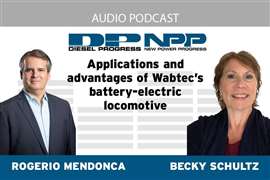Battery-electric power rides the rails
13 February 2024
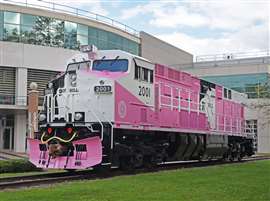 The FLXdrive locomotive that debuted at a ceremony last October featured Roy Hill’s iconic pink livery. (Photo: Wabtec Corporation)
The FLXdrive locomotive that debuted at a ceremony last October featured Roy Hill’s iconic pink livery. (Photo: Wabtec Corporation)
In late October 2023, transportation solution provider Wabtec and its launch customer Roy Hill, an Australia-based iron ore mining company, celebrated the debut of the FLXdrive locomotive – a production model unit that Wabtec described as the “world’s first 100% battery-powered, heavy-haul locomotive for mainline service.”
The debut was the culmination of more than a decade of R&D that started at a time when battery technology and density were far more limited. Rogerio Mendonca, president, Freight Equipment, Wabtec, labeled the company’s earliest project as “more of a science pilot than anything else.”
 Rogerio Mendonca, president, Freight Equipment, Wabtec
Rogerio Mendonca, president, Freight Equipment, Wabtec
The FLXdrive really got on track in 2021 in the form of a pilot locomotive developed in partnership with BNSF that ran for more than 13,000 miles. “It was a very, very successful pilot in many aspects,” Mendonca said. “That locomotive had about 2.4 MWh of power inside it. It was actually the first time that we had a real heavy haul, full-size battery-electric locomotive running [in] freight rail in real service...
“At that point, we realized that we were probably ready for a larger scale, commercial product based on battery technology.”
Scalable solution
Wabtec has partnered with a number of customers, including Roy Hill, on joint development of the FLXdrive heavy haul locomotive. These partnerships, along with rapid advances in battery technology, have influenced such aspects as how the batteries are packaged, the optimal amount of power on board, safety systems and more.
As a result, the production model – while it has physical similarities to the pilot locomotive – is a far cry from that pilot version. “[In 2021], we had this 2.4-MWh locomotive and the one that we’re delivering to Roy Hill has 7 MWh of power. So, [it is] the same physical structure, the same size of locomotive, but the technology… has allowed us to reach much higher levels of power density, which is one of the critical variables,” Mendonca said.
The FLXdrive locomotive has a modular and scalable battery architecture that is designed to be integrated across multiple rail vehicles and environments, including heavy-haul, yard, regional, commuter, hybrid and specialty locomotives. Maximum battery capacity ranges from as low as 1.5 to as high as 8.5 MWh, depending on the configuration and application.
The heavy-haul version is based on the premise of a diesel-electric locomotive, said Mendonca, but uses liquid-cooled lithium-ion battery packs in place of a diesel engine. An “entire deck of batteries” delivers the required power rating – a total of 72 battery packs in the case of the locomotive targeted for use by Roy Hill in Western Australia’s mining intensive Pilbara region.
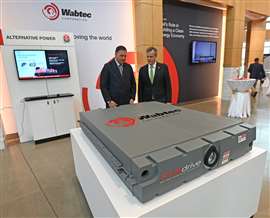 The FLXdrive locomotive has a modular and scalable battery architecture that is designed to be integrated across multiple rail vehicles and environments. (Photo: Wabtec Corporation)
The FLXdrive locomotive has a modular and scalable battery architecture that is designed to be integrated across multiple rail vehicles and environments. (Photo: Wabtec Corporation)
“That set of batteries is a complex system that not only has the battery cells in it but has all of the safety and control systems around it,” said Mendonca, including a proprietary thermal management system. “When we put that many batteries together, we want to make sure that we’re doing that in a safe and reliable way. And that comes with a number of accessories and systems to cool it, to manage it and make sure that the whole system operates in a stable way.”
While it can work independently, the FLXdrive heavy-haul locomotive was created to operate in a hybrid consist – replacing one of the diesel-electric units in, say, a three-unit “chain” of locomotives. Wabtec’s energy management system is used to optimize the energy within that consist.
“It determines, for example, when you’re going to use the battery versus when the battery is going to be charged, and what’s the optimal operation between the two [diesel] engines and that one locomotive running on battery,” Mendonca explained. “I would say probably one of the most fascinating parts of the technology is the ability to manage the distribution of the energy in the whole consist, not only for fuel optimization but also emissions.”
Downhill charge
Static charging and optional DC fast-charging utilizing a stationary pantograph are available for FLXdrive units, with plans to introduce optional moving-charge capabilities in future. The heavy-haul FLXdrive is also capable of “in-mission” regenerative brake charging.
“That function, I would say, is one of the most relevant aspects of emissions and fuel savings for that locomotive and simplifies the whole operation” by largely eliminating the need for static charging, Mendonca commented. “It is a function of the application because the topography defines a lot of the ability of these locomotives to generate recharging to the battery.
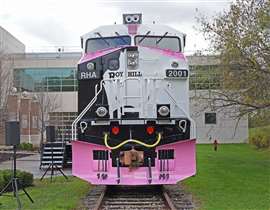 Roy Hill plans to integrate the battery-electric locomotives within their existing fleet as part of a hybrid consist. (Photo: Wabtec Corporation)
Roy Hill plans to integrate the battery-electric locomotives within their existing fleet as part of a hybrid consist. (Photo: Wabtec Corporation)
“We have customers that operate in a mining environment where typically you go from a mine at the top of a mountain to a port... In places like those, these locomotives will recharge many times only by the braking system. So, you could get to a point in a hybrid consist where you may not need to charge those battery-electric locomotives externally. They will be able to recharge throughout the route.”
In addition, the battery system incorporates the FLX Optimizer, a “smart cruise control system” for electric trains based on the Trip Optimizer for Wabtec’s diesel locomotives. “It is a system that manages the operation of the locomotive and determines points of braking, points of acceleration and helps achieve what we call the optimal run,” Mendonca said. “What’s the best way of taking a train from point A to point B? That system helps calculate – based on speed, points of stop, elevation – where the rights points are for acceleration and braking.
“The FLXdrive benefits a lot from that system, as well, for optimization of charging and discharging. That helps not only with the operation itself, but also with the life of the batteries by maintaining the optimal operation for that aspect.”
Lower cost and emissions
Such technology will be critical to delivering the performance customers like Roy Hill expect. The mining company currently operates four Wabtec ES44Aci Evolution Series diesel-electric locomotives that pull 240-car ore trains in a closed-circuit route that runs from its mine, on its own railway, to its port facilities and back. The company ships more than 63 million tons of ore to steel producers per year.
“They have the benefit of super reliable assets with a high level of availability. That’s critical for them because they basically operate that ‘conveyor belt’ that gets the ore from the mine to the port and comes back,” said Mendonca.
Given the route and the company’s rail operations, hybrid consists incorporating the FLXdrive locomotive are expected to provide a double-digit percentage reduction in fuel costs as well as emissions per train.
“The fundamental reason why the battery locomotives were developed is to help our customers with their decarbonization plans, whether in a consist where you have three diesels and you put one battery or two batteries [and] proportionally reduce the emissions, to a full train of batteries,” Mendonca stated. “That was the original concept – creating a product that will be able to operate in heavy haul with zero emissions. And I think the path is very promising.”
Roy Hill plans to integrate the battery-electric locomotives within their existing fleet while continuing to develop their diesel technology to make it more fuel efficient and reliable. “The combination of battery and diesel is definitely going to help them reach a very good, optimized point of fuel efficiency, haulage capability – all the variables that matter the most for a big mining company like Roy Hill,” said Mendonca.
He added, “The diesel-electric locomotives are still a very important part of our portfolio, a very important part of the operations of all our customers globally and will remain that way for some time. Diesel technology has evolved very quickly over the last several years in fuel consumption and… not only the CO2 emissions but the particulate emissions of the Tier 4 technologies. So, there is a very solid diesel-electric technology in the market that will be combined with batteries and gradually promote that transition.”
Ongoing development
The FLXdrive locomotive that will be delivered to Western Australia later in 2024 is being built at Wabtec’s manufacturing facility in Erie, Pa. “Since this is the first one, we’re building close to where our engineering is,” Mendonca said. “In the future, hopefully, they will be built in our factories around the world.”
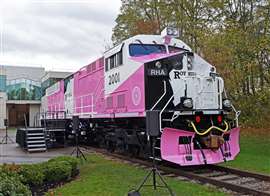 Product development will remain ongoing even once the locomotive is put into operation at Roy Hill’s mining operation in Pilbara, Australia. (Photo: Wabtec Corporation)
Product development will remain ongoing even once the locomotive is put into operation at Roy Hill’s mining operation in Pilbara, Australia. (Photo: Wabtec Corporation)
Product development will remain ongoing even once the locomotive is put into operation. “When these locomotives start to operate in Australia, we will be there with [Roy Hill] and we will be running the locomotives together. We will keep learning and we will keep feeding it back to the process of building and designing,” Mendonca said.
“This has been an interesting learning process for the industry in general,” he added, “and we’re lucky to have partners like Roy Hill that accelerate that learning together with us.”
The technology surrounding the batteries – not only in terms of battery density and lifecycle but the controls – will continue to evolve rapidly and drive even further advances in design, Mendonca predicted.
“From our pilot three years ago to the locomotives we’re building today, we already see a significant development. And I think the industry in general believes that the speed of improvement will continue,” he said. “It’s very, very promising. And we’re definitely looking forward to the next several years of development of the technology.”
CONTÁCTESE CON EL EQUIPO






